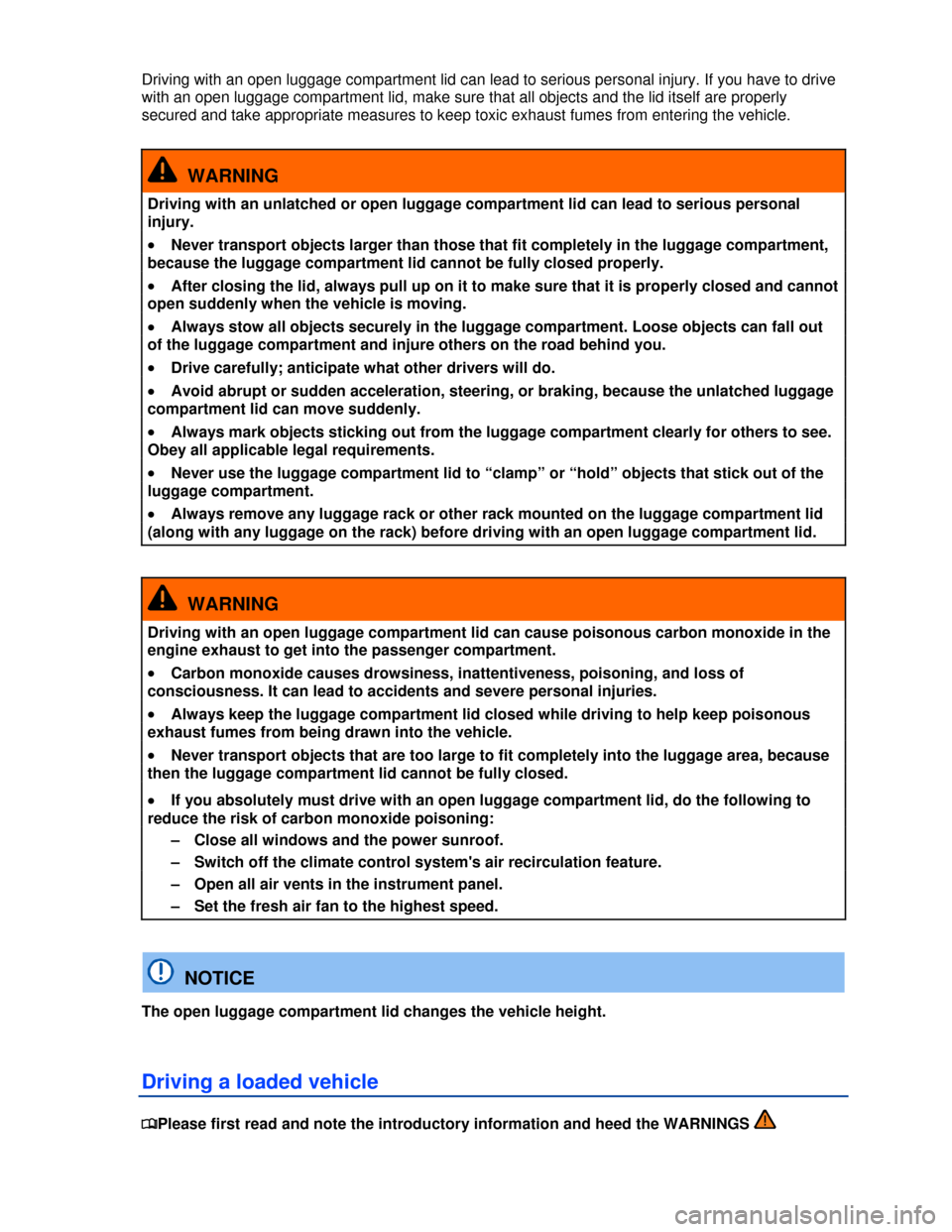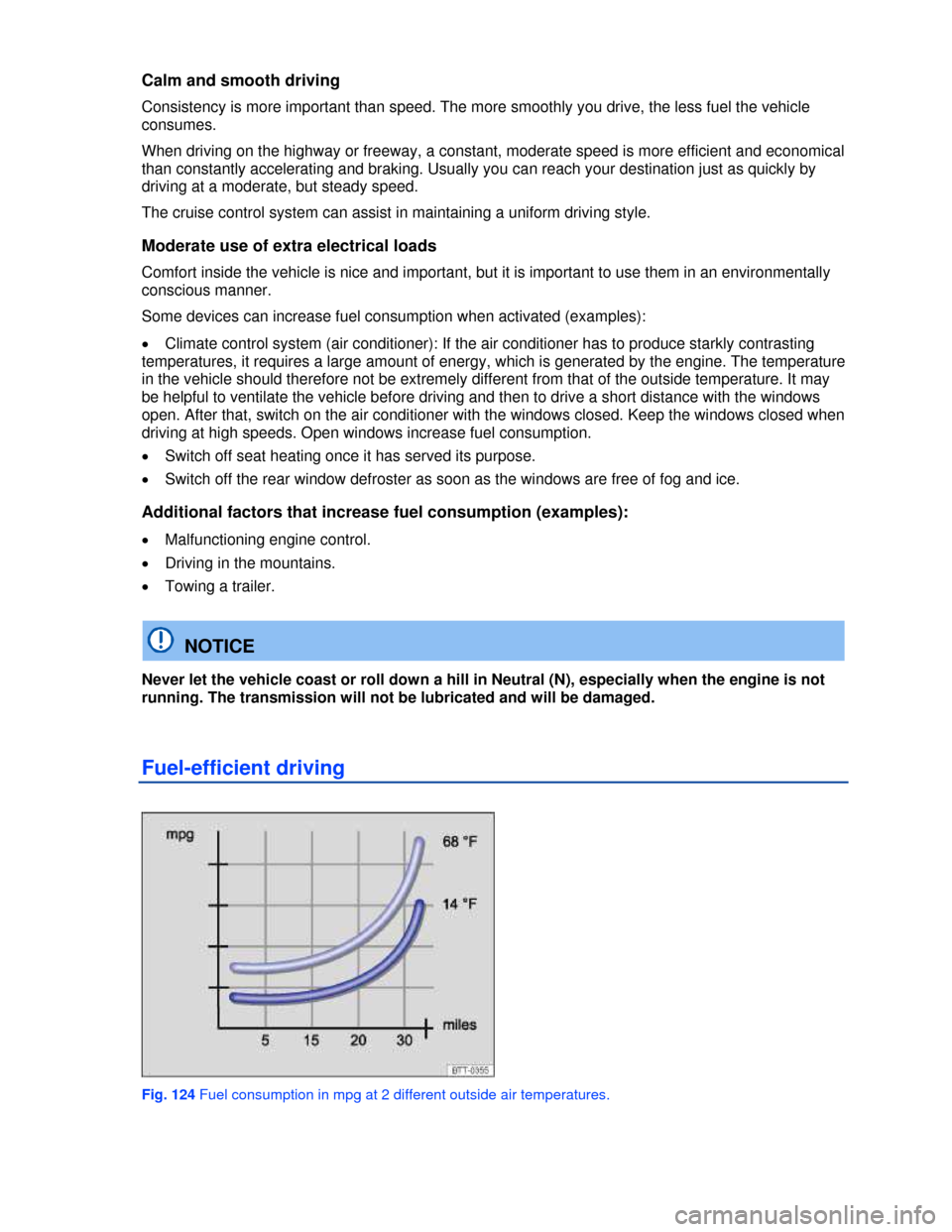2013 VOLKSWAGEN PASSAT CC climate control
[x] Cancel search: climate controlPage 126 of 353

Driving with an open luggage compartment lid can lead to serious personal injury. If you have to drive
with an open luggage compartment lid, make sure that all objects and the lid itself are properly
secured and take appropriate measures to keep toxic exhaust fumes from entering the vehicle.
WARNING
Driving with an unlatched or open luggage compartment lid can lead to serious personal
injury.
�x Never transport objects larger than those that fit completely in the luggage compartment,
because the luggage compartment lid cannot be fully closed properly.
�x After closing the lid, always pull up on it to make sure that it is properly closed and cannot
open suddenly when the vehicle is moving.
�x Always stow all objects securely in the luggage compartment. Loose objects can fall out
of the luggage compartment and injure others on the road behind you.
�x Drive carefully; anticipate what other drivers will do.
�x Avoid abrupt or sudden acceleration, steering, or braking, because the unlatched luggage
compartment lid can move suddenly.
�x Always mark objects sticking out from the luggage compartment clearly for others to see.
Obey all applicable legal requirements.
�x Never use the luggage compartment lid to “clamp” or “hold” objects that stick out of the
luggage compartment.
�x Always remove any luggage rack or other rack mounted on the luggage compartment lid
(along with any luggage on the rack) before driving with an open luggage compartment lid.
WARNING
Driving with an open luggage compartment lid can cause poisonous carbon monoxide in the
engine exhaust to get into the passenger compartment.
�x Carbon monoxide causes drowsiness, inattentiveness, poisoning, and loss of
consciousness. It can lead to accidents and severe personal injuries.
�x Always keep the luggage compartment lid closed while driving to help keep poisonous
exhaust fumes from being drawn into the vehicle.
�x Never transport objects that are too large to fit completely into the luggage area, because
then the luggage compartment lid cannot be fully closed.
�x If you absolutely must drive with an open luggage compartment lid, do the following to
reduce the risk of carbon monoxide poisoning:
– Close all windows and the power sunroof.
– Switch off the climate control system's air recirculation feature.
– Open all air vents in the instrument panel.
– Set the fresh air fan to the highest speed.
NOTICE
The open luggage compartment lid changes the vehicle height.
Driving a loaded vehicle
�
Page 201 of 353

Calm and smooth driving
Consistency is more important than speed. The more smoothly you drive, the less fuel the vehicle
consumes.
When driving on the highway or freeway, a constant, moderate speed is more efficient and economical
than constantly accelerating and braking. Usually you can reach your destination just as quickly by
driving at a moderate, but steady speed.
The cruise control system can assist in maintaining a uniform driving style.
Moderate use of extra electrical loads
Comfort inside the vehicle is nice and important, but it is important to use them in an environmentally
conscious manner.
Some devices can increase fuel consumption when activated (examples):
�x Climate control system (air conditioner): If the air conditioner has to produce starkly contrasting
temperatures, it requires a large amount of energy, which is generated by the engine. The temperature
in the vehicle should therefore not be extremely different from that of the outside temperature. It may
be helpful to ventilate the vehicle before driving and then to drive a short distance with the windows
open. After that, switch on the air conditioner with the windows closed. Keep the windows closed when
driving at high speeds. Open windows increase fuel consumption.
�x Switch off seat heating once it has served its purpose.
�x Switch off the rear window defroster as soon as the windows are free of fog and ice.
Additional factors that increase fuel consumption (examples):
�x Malfunctioning engine control.
�x Driving in the mountains.
�x Towing a trailer.
NOTICE
Never let the vehicle coast or roll down a hill in Neutral (N), especially when the engine is not
running. The transmission will not be lubricated and will be damaged.
Fuel-efficient driving
Fig. 124 Fuel consumption in mpg at 2 different outside air temperatures.
Page 279 of 353

Under- or over-inflation significantly shortens the service life of your tires and affects the handling of
the vehicle ⇒ . The correct tire pressure is very important, particularly when the vehicle is driven at
higher speeds. Incorrect tire pressure causes increased wear and even sudden tire failure and
blowouts.
Therefore, tire pressure should be checked at least once a month and always before long trips.
The specified tire inflation pressure applies to a cold tire. When tires are warm, the pressure will be
higher than when the tires are cold.
Do not reduce the tire pressure on warm tires to match the required cold tire inflation pressure. The
tire inflation pressure would then be too low and could cause sudden tire failure and blowout.
Checking tire inflation pressure
Always check the tire pressure only on “cold” tires when the vehicle has not been driven more than a
couple of miles (kilometers) at low speed within the last 3 hours.
�x Check tire inflation pressure regularly and on cold tires. Check all the tires, including the compact
spare, if any. In colder climates tire pressure should be checked more often, but only when the tires
are cold. Always use an accurate tire pressure gauge.
�x Adjust the tire pressure for heavy loads accordingly.
�x After adjusting the tire inflation pressures, make sure to screw the valve caps back on; replace
missing valve caps immediately. Please read and heed the information on resetting the Tire Pressure
Monitoring System, if necessary
�x Remember that the vehicle manufacturer, not the tire manufacturer, determines the correct tire
pressure for the tires on your vehicle. Never exceed the maximum inflation pressure listed on the tire
sidewall for any reason.
Inflate a spare wheel to the pressure specified for the vehicle's road wheels on the tire pressure label;
inflate a compact spare wheel to the pressure specified for the compact spare on the tire pressure
label or on a separate label for the compact spare, if there is one.
WARNING
Incorrect tire pressure can cause a sudden tire failure or blowout, loss of control, collision,
serious personal injury, and even death.
�x Always inflate tires to the recommended and correct cold tire pressure before driving off.
�x Low tire pressure can cause tires to get too hot, resulting in tread separation, sudden loss
of pressure, and blowouts. Tires with excessively low pressure flex (bend) more, which can
cause the tire to overheat and fail suddenly without warning.
�x Excessive speed and/or overloading can cause heat build-up, sudden tire failure including
a blowout and sudden deflation and loss of control.
�x If the tire pressure is too low or too high, the tires will wear prematurely and the vehicle
will not handle well.
�x Regularly check tire inflation pressure, at least once a month, and also especially before a
long trip.
�x Check the pressure in all 4 tires when the tires are still cold. Never reduce air pressure in
warm tires to match cold tire inflation pressure.
NOTICE
�x Make sure not to jam the tire pressure gauge into the valve stem. Otherwise, you can
damage the tire valves.
�x Driving without valve caps, with the wrong valve caps, or with valve caps that are not
properly screwed on can damage the tire valves. To help prevent damage, always use valve